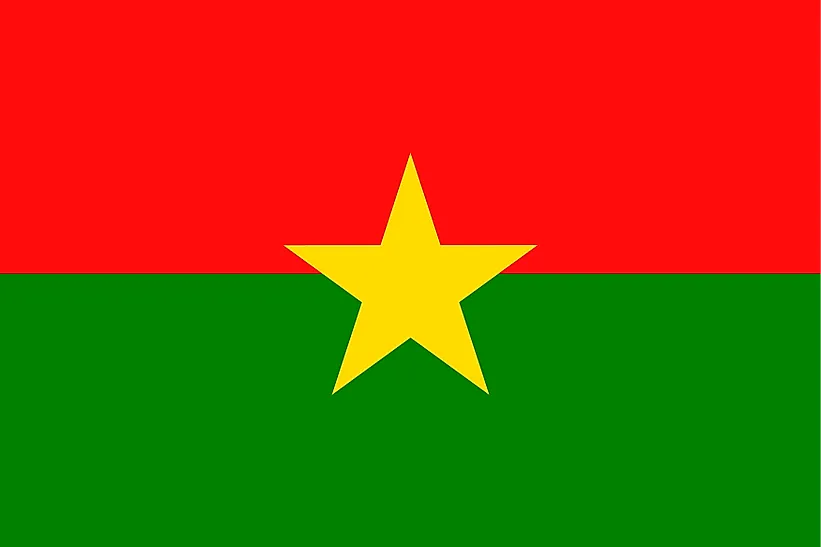
부르키나파소
| 대륙 | 아프리카 |
| 자본 | 와가두구 |
| 인구 | 19,512,533 |
| GDP | $32.99억 |
| 1인당 GDP | $1,800 |
| 다이얼링 코드 | +226 |
| ISO 코드(2글자) | BF |
| ISO 코드(3글자) | BFA |
부르키나파소 소개
무레어와 디울라어로 "올곧은 사람들의 땅"이라는 뜻을 가진 서아프리카 국가 부르키나파소에 오신 것을 환영합니다. 약 2,090만 명의 인구가 274,200평방킬로미터에 거주하는 이 내륙 국가는 풍부한 문화적 전통과 회복력과 존엄성을 겸비하고 있습니다. 부르키나파소는 다양한 도전에 직면해 있지만 활기찬 예술계, 문화적 다양성, 사회 발전을 위한 노력으로 유명합니다.
지리적 특징과 자연의 아름다움
부르키나파소의 지형은 서쪽과 남동쪽에 약간의 언덕이 있는 주로 평평한 지형이 특징입니다. 이 나라는 북쪽의 사하라 사막에서 남쪽의 비옥한 지역으로 넘어가는 사헬 지역에 위치하고 있습니다. 이로 인해 북쪽의 사헬, 중앙의 수단-사헬, 남서쪽의 수단-기니 등 세 개의 뚜렷한 기후대가 형성됩니다.
이 나라에는 남서쪽의 극적인 기암괴석인 신두 봉우리, 반포라 근처의 카르피겔라 폭포 등 주목할 만한 자연 명소가 여러 곳 있습니다. 유네스코 생물권 보전 지역인 마레 오 히포포타메스 국립공원은 하마와 다양한 조류 종의 서식지를 제공합니다.
남쪽의 나징가 게임 목장에서는 코끼리와 다른 야생 동물을 관찰할 수 있으며, 듀스 발레 국립공원에서는 서아프리카 사자와 코끼리의 중요한 개체군을 보호하고 있습니다.
문화 유산과 전통
부르키나베의 문화는 매우 풍부하고 다양하며 60개 이상의 민족이 각자의 고유한 전통, 언어, 관습을 유지하고 있습니다. 가장 큰 민족인 모시족은 현대 국가 구조와 함께 전통적인 정치 체제를 보존하고 있으며, 모호 나바(모시족 왕)는 여전히 중요한 문화적 역할을 담당하고 있습니다.
와가두구는 예술과 공예, 특히 청동 주조, 가면 제작, 전통 직물로 유명한 나라입니다. 와가두구에서 격년으로 열리는 페스파코(범아프리카 영화 및 텔레비전 페스티벌)는 아프리카에서 가장 큰 영화제로, 아프리카 영화의 문화 허브로 자리매김하고 있습니다.
전통 음악과 춤은 여전히 일상 생활의 중요한 부분으로 남아 있으며, 각 민족은 고유한 스타일을 유지하고 있습니다. 또한 보보-디울라소의 진흙 사원과 티에벨레의 왕궁 등 전통 건축물로도 유명합니다.
역사 여행
부르키나파소의 역사는 수세기 동안 이슬람의 정복과 유럽의 식민지배에 저항한 모시 왕국을 비롯한 고대 왕국과 제국에 걸쳐 있습니다. 이 지역은 1896년 프랑스 보호령이 되었다가 1960년 어퍼 볼타로 독립했습니다.
1984년 토마스 산카라의 지도력 아래 부르키나파소는 자립과 존엄성에 대한 의지를 반영하여 국명을 부르키나파소로 변경했습니다. 산카라의 혁명 시기는 짧았지만 사회 발전과 범아프리카 연대의 지속적인 유산을 남겼습니다.
현대 경제 환경
오늘날 부르키나파소의 경제는 주로 농업, 가축 사육, 광업에 기반을 두고 있습니다. 목화가 주요 현금 작물이며, 금 채굴이 경제에서 점점 더 중요해지고 있습니다. 부르키나파소는 경제를 다각화하고 다양한 분야에서 투자를 유치하기 위해 많은 노력을 기울이고 있습니다.
부르키나파소는 경제적 어려움에도 불구하고 농업 개발과 재생 에너지 등의 분야에서 놀라운 회복력과 혁신을 보여주었습니다. 부르키나파소는 지속 가능한 농업과 수자원 관리 분야에서 성공적인 프로그램을 개척해 왔습니다.
국제 관계 및 글로벌 포지셔닝
부르키나파소는 서아프리카 경제공동체(ECOWAS) 및 아프리카 연합과 같은 지역 조직에 적극적으로 참여하고 있습니다. 부르키나파소는 지역 평화 유지 노력과 문화 교류에서 중요한 역할을 해왔습니다.
알고 계셨나요?
- 부르키나파소에서 아프리카 최대 공예품 시장인 와가두구 국제 예술 공예 박람회(SIAO)를 개최하나요?
- 아프리카 영화와 페스파코 영화제에서 두드러진 역할을 해 '아프리카의 할리우드'로 불리는 나라는 어디인가요?
- 티에벨레의 전통 카세나 건축은 집 위에 그려진 복잡한 기하학적 무늬가 특징인가요?
- 이 나라에는 특히 청동 주조와 가면 제작으로 유명한 서아프리카에서 가장 큰 공예 커뮤니티 중 하나가 있나요?
결론
부르키나파소는 국민들의 회복탄력성과 창의성을 보여주는 증거입니다. 활기찬 예술계부터 전통 문화, 환경 보존 노력, 사회 혁신에 이르기까지 부르키나파소는 문화적 정체성을 유지하면서 발전을 향한 길을 계속 개척해 나가고 있습니다. 부르키나파소는 기후 변화와 지역 안보 문제 등 당면한 도전에 직면해 있지만 존엄성, 청렴성, 사회 발전이라는 건국 원칙을 지키기 위해 최선을 다하고 있습니다.





